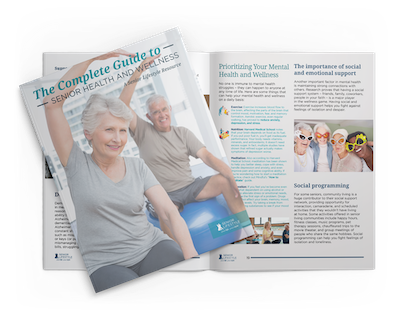No matter your age, there are plenty of things you can do to improve your health and keep your body well. Unsurprisingly, nutrition and exercise are at the top of that list.
Have you heard of Ginette Bedard? At age 68, she began running as her new hobby. By age 86, she has now run hundreds of races, including nearly 20 marathons.
Or how about 82-year-old Ernestine Shepherd, the world’s oldest competitive female bodybuilder, who didn’t start working out until she was 56? Both of these women are redefining what can be expected in senior health, and their nutrition and exercise routines are critical pieces of how they do it.
Here’s a look at the kinds of foods seniors should consider, as well as a few to avoid. Read on for research insights and health tips, and find out more about senior communities that can help support health and well-being.
Why Nutrition is Especially Important for Seniors and Longevity
Even the healthiest among us often deal with arthritis, hearing loss, cataracts, loss of muscle, memory loss, back pain, and changing hormone levels. As the prevalence of disease increases; many older adults must manage health problems arising from heart disease, cancer, osteoporosis, diabetes, or the onset of brain-related diseases such as Alzheimer’s or Parkinson’s. Nutrition for seniors is vital to help keep the bodies health at its best.
Common nutrition issues for elders
Whatever your age, remember that your organs, your teeth, your skin, your bones, your nervous system, and your brain are the same age. Sure, new cells regenerate constantly, but it’s a fact that there are more challenges for 70-year-old bones or a 70-year-old heart than for their younger counterparts. This is a big reason why seniors need to fight nutritional deficiencies and eat with health in mind. Some specific nutritional issues that older adults must face include:
- Atrophic gastritis: The most significant change in how an estimated 20% of the elderly population uses nutrients is atrophic gastritis, which causes you to malabsorp such things as folic acid, vitamin B-12, vitamin D, iron, and calcium. Even more people (up to 50%) have chronic gastritis, which can lead to atrophic gastritis.
- Excess calories: As we age, our metabolic rate generally becomes slower, resulting in a need for fewer calories overall. If we consume too many calories without burning them off with exercise, we accumulate fat. In older people, this fat tends to accumulate in the abdominal area, which can interfere with proper liver function and can cause issues with glucose (sugar) and lipids (fatty acids). Some of these issues can be minimized with proper nutrition and exercise.
- Hormone changes: In women, hormonal changes brought on by menopause (which typically occurs between the ages of 45 and 55, though it can go later) are associated with increased total body fat and abdominal fat. This extra weight raises the risk of cardiovascular disease and affects sexual function and quality of life.
- Muscle loss: It’s common to lose muscle and strength as you age (called sarcopenia) unless you regularly exercise and use weight-bearing routines to help counteract the tendency. Without this deliberate strength-building, bones become weaker which leads to an increase of falls and fractures. Approximately 20% of those younger than 70 but 50% of those over 80 are affected by sarcopenia.
- Constipation: Constipation is a common problem as people age, especially those over 65, and more often in women. The reasons? Less exercise, and more medications that list it as a possible side effect. A diet rich in fiber not only helps relieve constipation, it can also help prevent diverticular disease, which can develop into diverticulitis and may present a need for surgery.
- Dehydration: As we age, we are more prone to dehydration; it is the most common fluid and electrolyte problem found in the elderly. Dehydration “affects large numbers, contributes to or exacerbates other severe medical conditions, may cause acute confusion and disorientation, and severely impairs the elderly individual’s quality of life,” according to the journal Clinical Nutrition Espen. We may also lose our regular feelings of hunger or appetite, due to lower levels of hunger hormones, higher levels of fullness hormones, and changes in taste and smell.
Nutritional deficiencies of any kind (whether it’s because you don’t take enough of the nutrient in, or because your body isn’t processing it like it used to) can help contribute to inefficiencies in the body’s ability to fight disease. We all know that habits like smoking, drinking too much, being obese, and a sedentary lifestyle are unhealthy. But we also know that quitting smoking, losing weight, and getting more movement into our lives will benefit us at every level (Don’t forget the two amazingly healthy women we introduced you to at the beginning of this article!).

Download The Complete Guide to Health & Wellness for Seniors
As people grow older, their health and wellness needs change. Read our eBook, “The Complete Guide to Health & Wellness for Seniors” for everything you need to know about staying healthy and happy as we age.
Download the Guide
Nutrition habits in the healthiest parts of the world
A National Geographic researcher took a decade to determine the five “blue zones” that are home to the healthiest people in the world. Among these populations are high concentrations of people who live to be 100 and tend not to be afflicted with heart disease, obesity, cancer, or diabetes.
Overall, Blue zone residents tend to eat smaller amounts at a time, move more, have vibrant social and community interactions, drink coffee and wine, sleep more, exercise more, and eat more vegetables and less meat and dairy. Below is a summary of the diets associated with these healthy blue zones.
Ikaria, Greece:

- Ikaria residents enjoy lower rates of middle-age mortality and dementia than in typical places. The traditional Mediterranean diet is key, dominated by healthy fats (olive oil prime among them) and vegetables, where meat and dairy play a smaller role.
Okinawa, Japan:

- The world’s oldest women live here; locally grown sweet potatoes are the bulk of their diet, followed by rice, grains, soybeans and vegetables. Sugars, dairy, fish, eggs, and meat make up only one percent each of their diet.
The Mountain Highlands of Sardinia:

- The world’s highest concentration of 100-year-old people live here; they consume a low-protein diet and drink one to two glasses of Cannonau wine daily, which contains antioxidants and flavonoids.
Loma Linda, California:

- A large community of Seventh-day Adventists lives here, favoring a biblical diet that includes oatmeal, beans, fruits, nuts, vegetables, and grains.
Nicoya Peninsula, Costa Rica:

- People here enjoy the world’s lowest rate of middle-age mortality. They eat local foods – 70% consists of beans, squash, and corn tortillas, a combination of foods that include complete proteins and amino acids.
Longevity expert and Buettner has written a book sharing his research findings, titled The Blue Zones Solution: Eating and Living Like the World’s Healthiest People. In it, he suggests that Westerners could extend their lives by as many as a dozen years if they overhaul their diets to align with people who live in the blue zones.
Healthiest Foods for Seniors
So what can we do to improve our diets if we don’t live in these places of natural longevity bounty? We can start eating more like those individuals do. A few key words are important: water, antioxidants, vitamins, minerals, healthy fats, fiber, lean protein.
Water:
We can’t overstate the importance of drinking enough water and staying hydrated. This means four to eight glasses of water a day. Your body uses water for everything – don’t let it run out.
Antioxidants:
Antioxidants are extremely powerful compounds that protect against disease; they have been found to help prevent heart disease and some forms of cancer. Foods high in antioxidants include:
- Strawberries
- Artichokes
- Dark chocolate
- Blueberries
- Beans
- Raspberries
- Kale
- Red cabbage
- Spinach
- Beets
- Goji berries
- Spinach
- Pecans
Vitamins and minerals:
Not only are there nearly unlimited brands that compete for your attention on the store shelves, there are hundreds of vitamins and supplements available, each touting their advantages. A high-quality multivitamin is never a bad idea if you know your diet is lacking, but the ideal way to ingest vitamins is with your food.
Important vitamins for seniors include:
- Vitamin A
- B vitamins (B1, B2, B3, B5, B6, B7, B9, B12)
- Vitamin C
- Vitamin D
- Vitamin E
- Vitamin K
Important major minerals for seniors include:
- Calcium
- Chloride
- Magnesium
- Potassium
- Sodium
- Trace
- Chromium
- Copper
- Fluoride
- Iodine
- Iron
- Magnesium
- Selenium
- Zinc
Healthy fats:
We all need some fat in our diets; it has important functions in the body. But the type of fat is critical. You want to avoid saturated fats, trans fats, and cholesterol, and seek out healthy fats instead. Here are some healthy fats, divided into monounsaturated fats, polyunsaturated Omega-6 fat
Monounsaturated fats include:
- Olive oil
- Canola oil
- Sunflower oil
- Most vegetable oils
- Avocados
- Nut
Polyunsaturated Omega-6 fatty acids can be found in:
- Vegetable oils
- Soybean oil
- Corn oil
- Safflower oil
Polyunsaturated Omega-3 fatty acids can be found in:
- Vegetable oils
- Soybean oil
- Canola oil
- Walnuts
- Salmon
- Trout
- Herring
If you’re unsure about a food, check the nutrition label – it should break out the facts by type.
Fiber:
The recommendation for women is to eat 21-25 grams of fiber a day, and 30-38 grams of fiber a day for men. High-fiber foods include fruits (a cup of raspberries has 8 grams), vegetables (a cup of chopped broccoli has 5 grams), grains (a cup of cooked whole-wheat spaghetti has 6 grams), legumes (a cup of black beans has 15 grams), nuts and seeds (an ounce of sunflower seeds contains 3 grams).
Lean protein:
Protein is vital to our diets. It builds and protects our muscles, organs, skin, hormones, and more, but it’s the type of protein that makes a difference. If you get the bulk of your protein from red meat, whole milk, full-fat yogurt, and cheese, for example, the amount of fat you’re taking in actually undermines the good the protein can do. Seek out low-fat sources of protein instead.
Low-fat sources of protein include:
- Lean chicken
- Turkey breast
- Fish
- Shrimp
- Dairy products (made with low-fat or skim milk)
- Greek yogurt
- Egg whites
- Almonds
- Broccoli
- Oats
- Quinoa
- Brussels sprouts
- Beans
- Legumes
Is red meat out altogether? No, but you should limit it and should be a lean cut. Three ounces of cooked beef that had a 10%fat percentage contains 22 grams of protein and has 184 calories.
Foods Seniors Should Avoid
Foods high in sugar:
We all know that sugar is a culprit in lots of foods. Not only does it show up in expected places like ice cream or cookies, it also is present in a lot of unexpected places, often in the form of corn syrup.
Foods that can have unexpectedly high sugar content include:
- Soups
- Pasta sauces
- Instant oatmeal packets
- Whole-grain bread
- Salad dressings
- Peanut butter
- Yogurt
- Condiments
- Cured meats
- Cereal (even healthy types – check the nutrition label)
- Alternative milks like soy or almond
In addition, because there are so many names for sugar, it might be listed on a label in multiple ways: sugar, corn syrup, dextrose, fructose, cane juice, honey, lactose, malt syrup, glucose, fruit nectar, sucrose, and liquid fructose.
There’s nothing wrong with a little bit of sugar. In fact, there’s nothing wrong with a little bit of most foods. But the Diabetes Council says the United States now ranks No. 1 in the consumption of sugar worldwide, with an average 17 teaspoons per day per person, which translates to about 57 pounds of added sugar per year. Because you can go through your food day with sugar around every corner (in your coffee drink, in your cereal or oatmeal, in your turkey and bread for your sandwich at lunch, in a donut or bagel at the office, in salad dressing, in canned foods, in soda, in frozen foods, in dairy products and in actual desserts), you can see how it adds up quickly without our awareness. Contrast that with the American Heart Association’s recommendation of six teaspoons of added sugar a day for a woman and nine teaspoons for a man, and you’ll see how far we’ve gone into scary territory.
Sugar gets so much attention because it affects our bodies in so many different ways. The excess in calories causes rapid weight gain. We have higher levels of sugar (glucose) in our bloodstream, meaning our bodies are releasing insulin more often – and that insulin causes extra calories to be stored as fat. Insulin also affects leptin, a natural appetite suppressant that tells us when we’re full; without leptin, we can eat excessively and never get the brain signal that we’ve had enough.
Other foods that are unhealthy for seniors:
Besides sugar, there are some surprising foods that older populations may want to avoid, including:
- Soft cheeses: Many are made without pasteurized milk, and they contain more bacteria. Soft cheeses to avoid include feta, Brie, ricotta, Chevre, gorgonzola, Roquefort, Camembert, panela, and cotija.
- Grapefruit: There are specific medications that are dangerous when taken in conjunction with grapefruit; some of them treat insomnia, high blood pressure, high cholesterol, or anxiety. Check with your doctor to see if grapefruit may cause an adverse reaction.
- Deli meats: Eating deli meats too often introduces sodium, nitrates, and other additives. Too much of these raise the risks of cancer and heart disease.
- Sprouts: Raw or barely cooked sprouts can be sources of bacteria, and may cause digestion trouble for seniors.
- Raw or undercooked meat or poultry: Especially when you’re eating at someone’s house (a barbecue, for example),be sure that all the meat you consume is completely cooked. Undercooked meat or poultry can cause food poisoning. If you are the chef, be sure that the plates and utensils used for raw food are different from the ones you use for the cooked food, and wash your hands between handling raw meat and handling the cooked meat.
- Fast food: Moderation in all things, remember? Occasional fast food is a treat, but too much of it contributes to obesity.
- Oysters: Do you have a sensitive immune system? You should avoid eating raw shellfish, which come in contact with viruses and bacteria.
- Sushi: Ask if the fish has been frozen first; if so, the tiny parasitic worms in some raw fish will have been killed, making the fish safe to eat.
- Bagels: The high glycemic level of a bagel can raise your insulin level and increase inflammation.
- Undercooked eggs: Maybe you’ve always liked your eggs a little runny? We beg you to reconsider. Uncooked and undercooked eggs can increase your chances of getting food poisoning.
More nutrition resources for seniors:
While healthy eating only has benefits to your body, there’s no doubt it does take time, effort, and education to successfully implement in your life. Below are some additional resources to learn more about senior nutrition.
National Council on Aging: Healthy Eating Tips for Seniors
Eat Right: Academy of Nutrition and Dietetics | For Seniors
USDA: National Agricultural Library | Older Individuals
National Institute on Aging | Sample Menus: Healthy Eating for Older Adults
Senior Lifestyle | Healthy for Good
While a common theme of young people and even middle-aged people to “eat whatever they want”, nutrition becomes more important as you age to ensure a healthy body. We recommend a life-long commitment to healthy eating, though it’s never too late to start! Making sure that you consume healthy fruits and vegetables, lean meats, good fats, and high fiber will go a long way to improving your energy levels and your quality of life.

